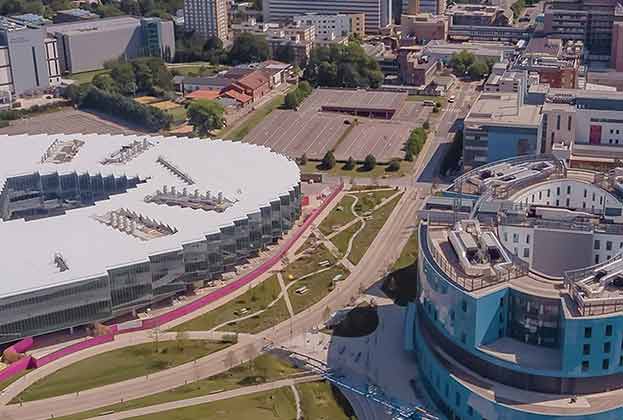How can the delivery of physical infrastructure in Cambridge be aligned with the planning process?
Beyond identifying enough land to accommodate Cambridge’s growth potential, the other key obstacle is ensuring the infrastructure is in place to make any development sustainable. For Cambridge, there are two key areas that need addressing: electricity and water. Both of these have implications for the phasing and speed of development, as potentially adding additional costs that could impact land values.
Electricity
Cambridge and South Cambridgeshire currently use around 1.49TWh of energy per year, but this level of demand is expected to triple by 2031 based on currently planned development, business growth and electrification of the energy supply. A greater level of development in line with government ambition would put even more pressure on the grid.
With current energy use, a circuit of 1 MVA can support 550 homes. But it is projected that with increased use of electric vehicles and electric heating and cooling, this figure will fall to just 100 homes. Sites for energy-intensive commercial uses or those larger than 100 homes are at risk of significant delays due to an inability to connect to the grid. Schemes comprising 5,700 homes and 270,000 sq m of commercial space consented or allocated in the Local Plan are already affected.
The Greater Cambridge Partnership (GCP) has been investigating this challenge, and has identified three substations critical to the economic growth and development of the area: Cambridge East, Trumpington Primary and Cambridge West. The GCP has put together a business case to deliver two of these substations over a 5-year period, taking total grid capacity around Cambridge from 240MVA to 310MVA. The GCP had originally planned to contribute to the funding of these upgrades using City Deal money, but Ofgem has now agreed to fully fund work to be carried out by UK Power Networks, recognising the high importance of the scheme.
However, a plan for delivering the final substation at Cambridge West hasn’t been announced, where an additional 50MVA of capacity could be created. This could pose delays to development to the north and west of the city. It remains to be seen whether GCP still has the appetite to contribute catalyst funding towards the estimated £19m cost, or if forward funding payments from those seeking to develop in the area will be needed. The main concern for developers will be a timeline for delivery that aligns with the Local Plan and gives certainty that sites would be delayed by power requirements.
Water
Further considerable challenges are posed by the need to increase the water supply in Cambridge. Although new development doesn’t yet have to prove water neutrality, as has been imposed in Horsham, analysis by the Environment Agency has found that there isn’t sufficient infrastructure to deliver the growth set out in the existing Local Plan, let alone the Government’s larger target.
Anglian Water and Cambridge Water are already planning to deliver a new reservoir in the Fens, capable of supplying 100 million litres of water daily, as well as a further scheme in Lincolnshire which will also serve the East of England. This would provide water for at least 750,000 homes. But the reservoirs have been in progress for a decade already, and are unlikely to be operational until the mid-2030s.
This highlights the challenging nature of delivering large scale infrastructure. A key concern for Cambridge’s growth prospects is whether developers will have the certainty they need to be able to begin progressing large sites through planning. In a letter to central Government in 2023, Cambridge and South Cambridgeshire warned that water shortages risked significantly undermining the development plan. The Financial Times reported that there is a possibility that planning consent will not be granted for more than 9,000 homes and almost 700,000 sq m of commercial space currently in the pipeline, and the Environment Agency has raised objections to five planning applications, with capacity for over 4,000 homes.
Whether through a development corporation, or another overarching body such as Homes England, the growth of Cambridge will only happen with clear timelines for investment and delivery of new physical and social infrastructure, aligned with the Local Plan process
Emily Williams, Director, Residential Research
Co-ordination
For any large-scale expansion of Cambridge to be successful, there will need to be greater co-ordination between locally led planning decisions, and the delivery of national strategic infrastructure, bringing together both the public and the private sector. Michael Gove has announced plans to establish a development corporation for Cambridge, with the “full powers necessary” to lead a project of this scale.
Whether through a development corporation, or another overarching body such as Homes England, the growth of Cambridge will only happen with clear timelines for investment and delivery of new physical and social infrastructure, aligned with the Local Plan process. Alongside the electricity and water challenges highlighted here, this also has to include the provision of education, health and social care, as well as a range of housing tenures to ensure the city retains its essential key workers.
Read the articles within Spotlight: Good growth for Cambridge below.
.jpg)

